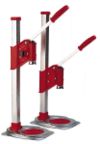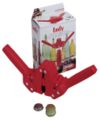m (Storing your beer moved to Storing Your Beer) |
(Deleted spam links) |
||
| (35 intermediate revisions by 12 users not shown) | |||
| Line 1: | Line 1: | ||
| + | [[Category:Beer]] | ||
For the homebrewer, there are two main options for storing beer: [[bottles]] and [[kegs]]. | For the homebrewer, there are two main options for storing beer: [[bottles]] and [[kegs]]. | ||
| − | == | + | == Bottles == |
| + | {{main|Bottles}} | ||
A typical five gallon batch of beer will yield approximately fifty 12oz bottles, forty 16oz bottles, or twenty-five 750mL bottles. | A typical five gallon batch of beer will yield approximately fifty 12oz bottles, forty 16oz bottles, or twenty-five 750mL bottles. | ||
| + | |||
| + | The equipment needed to bottle beer includes: A capper (either a wing capper or a bench capper), a bottling wand for easy filling of bottles, a siphon or a bucket with a spigot, a 4 or 5 foot length of tubing, bottles and bottle caps. | ||
| + | |||
| + | [[Image:bench-capper.jpg|thumb|100px|Bench Capper.]] | ||
| + | [[Image:2-handle-capper.jpg|thumb|100px|Wing Capper.]] | ||
| + | Pry-off bottles are preferred to twist-off bottles. Twist-off bottles are hard to cap, especially with a wing capper, and may not hold their seal. | ||
| + | |||
| + | Brown bottles are preferred to green or clear bottles. Brown bottles protect the beer from light exposure which results in "skunky" flavor and aroma. | ||
| + | |||
| + | Many homebrewers obtain their bottles by saving their commercial beer bottles after drinking. | ||
===Advantages=== | ===Advantages=== | ||
| − | + | The biggest advantage to bottling is that it requires very little special equipment, making it a cheap and easy way to store your beer, especially for new homebrewers. | |
| − | + | ||
| − | + | Bottles are easy to give away as presents or take to a party, and all homebrew competitions require entries to be bottled. | |
| − | + | ||
| + | Homebrewers who keg their beer will often bottle some "big" beers, such as Barley Wines and Russian Imperial Stouts. These big beers benefit from extended aging and bottling is a convenient method of storing and serving that doesn't use up a keg tap for extended periods of time. | ||
===Disadvantages=== | ===Disadvantages=== | ||
| − | + | Bottling is more time consuming than kegging. A typical homebrewer will take 2 to 3 hours to bottle 5 gallons of beer. Much of this time is spent cleaning and sanitizing the bottles. | |
| − | |||
| − | |||
| − | + | A second disadvantage of bottling is less direct control over carbonation. Some batches may end up not carbonated enough or be over carbonated. Bottles typically take between 1 and 3 weeks to reach peak carbonation, though this time may be longer in some cases. | |
| − | One five gallon batch yields one five gallon keg | + | If a batch is highly overcarbonated the pressure inside the bottle may be enough to crack or even break the bottle (a situation known as "bottle bombs"). |
| + | |||
| + | == Kegs == | ||
| + | {{main|Kegs}} | ||
| + | |||
| + | One five gallon batch yields one five gallon keg. | ||
===Advantages=== | ===Advantages=== | ||
| Line 26: | Line 42: | ||
;Cleaning: Sanitizing one keg is quick and easy. | ;Cleaning: Sanitizing one keg is quick and easy. | ||
;Filling: Filling a keg is as simple as racking from your fermenter and sealing the keg. | ;Filling: Filling a keg is as simple as racking from your fermenter and sealing the keg. | ||
| − | ;Force Carbonation: Instead of using priming sugar, you can force carbonate | + | ;Force Carbonation: Instead of using priming sugar, you can force carbonate (with C02) which can speed along the beer towards being ready to drink. |
;Consistency: The entire batch will have consistent flavor and carbonation. | ;Consistency: The entire batch will have consistent flavor and carbonation. | ||
| Line 33: | Line 49: | ||
;Cost: The initial costs of kegging equipment are high. | ;Cost: The initial costs of kegging equipment are high. | ||
;Portability: Kegs are more difficult to move from place to place than bottles. | ;Portability: Kegs are more difficult to move from place to place than bottles. | ||
| − | ;Storage: Kegs | + | ;Storage: Kegs can be stored warm, but the entire keg should be chilled in order to serve, which usually requires more room than bottles and possibly a separate refrigerator. |
| + | |||
| + | == Casks == | ||
| + | {{main|Casks}} | ||
| + | |||
| + | A cask is a vessel that is used to condition the ale and to serve from. After primary fermentation the ale is racked to the casks, primed and bunged. CO2 is not used for carbonation or serving, the ale is pulled from the cask by a [[beer engine]]; this results in low carbonation levels. Depending on the region of the UK, sometimes [[sparklers]] are fitted to the beer engine to release the CO2 from the ale and create a foamy head. Cask conditioned beer is referred to as [[Real Ale]]. | ||
| − | + | Originally casks were wooden, but for reasons of cost and durability they were mainly replaced by stainless steel casks. Plastic casks are now also becoming more common. | |
| − | + | Homebrewers not wishing to use casks but wanting to replicate cask conditioned "Real Ale" can achieve similar results with kegs by reducing the amount of primer to suit the style, and using a standard beer tap with a low CO2 serving pressure. A problem with doing this can be trub settling in the kegs and affecting the clarity of the served beer. This can be partially rectified by the addition of finings and making sure the keg is not disturbed for several days before and during serving. Cutting an inch or so off the end of the dip tube may also help. | |
| − | |||
| − | |||
| − | |||
Latest revision as of 22:11, 16 August 2009
For the homebrewer, there are two main options for storing beer: bottles and kegs.
Bottles
{{ #if: | Main article: [[Bottles|]] | Main article: Bottles }}
A typical five gallon batch of beer will yield approximately fifty 12oz bottles, forty 16oz bottles, or twenty-five 750mL bottles.
The equipment needed to bottle beer includes: A capper (either a wing capper or a bench capper), a bottling wand for easy filling of bottles, a siphon or a bucket with a spigot, a 4 or 5 foot length of tubing, bottles and bottle caps.
Pry-off bottles are preferred to twist-off bottles. Twist-off bottles are hard to cap, especially with a wing capper, and may not hold their seal.
Brown bottles are preferred to green or clear bottles. Brown bottles protect the beer from light exposure which results in "skunky" flavor and aroma.
Many homebrewers obtain their bottles by saving their commercial beer bottles after drinking.
Advantages
The biggest advantage to bottling is that it requires very little special equipment, making it a cheap and easy way to store your beer, especially for new homebrewers.
Bottles are easy to give away as presents or take to a party, and all homebrew competitions require entries to be bottled.
Homebrewers who keg their beer will often bottle some "big" beers, such as Barley Wines and Russian Imperial Stouts. These big beers benefit from extended aging and bottling is a convenient method of storing and serving that doesn't use up a keg tap for extended periods of time.
Disadvantages
Bottling is more time consuming than kegging. A typical homebrewer will take 2 to 3 hours to bottle 5 gallons of beer. Much of this time is spent cleaning and sanitizing the bottles.
A second disadvantage of bottling is less direct control over carbonation. Some batches may end up not carbonated enough or be over carbonated. Bottles typically take between 1 and 3 weeks to reach peak carbonation, though this time may be longer in some cases.
If a batch is highly overcarbonated the pressure inside the bottle may be enough to crack or even break the bottle (a situation known as "bottle bombs").
Kegs
{{ #if: | Main article: [[Kegs|]] | Main article: Kegs }}
One five gallon batch yields one five gallon keg.
Advantages
- Cleaning
- Sanitizing one keg is quick and easy.
- Filling
- Filling a keg is as simple as racking from your fermenter and sealing the keg.
- Force Carbonation
- Instead of using priming sugar, you can force carbonate (with C02) which can speed along the beer towards being ready to drink.
- Consistency
- The entire batch will have consistent flavor and carbonation.
Disadvantages
- Cost
- The initial costs of kegging equipment are high.
- Portability
- Kegs are more difficult to move from place to place than bottles.
- Storage
- Kegs can be stored warm, but the entire keg should be chilled in order to serve, which usually requires more room than bottles and possibly a separate refrigerator.
Casks
{{ #if: | Main article: [[Casks|]] | Main article: Casks }}
A cask is a vessel that is used to condition the ale and to serve from. After primary fermentation the ale is racked to the casks, primed and bunged. CO2 is not used for carbonation or serving, the ale is pulled from the cask by a beer engine; this results in low carbonation levels. Depending on the region of the UK, sometimes sparklers are fitted to the beer engine to release the CO2 from the ale and create a foamy head. Cask conditioned beer is referred to as Real Ale.
Originally casks were wooden, but for reasons of cost and durability they were mainly replaced by stainless steel casks. Plastic casks are now also becoming more common.
Homebrewers not wishing to use casks but wanting to replicate cask conditioned "Real Ale" can achieve similar results with kegs by reducing the amount of primer to suit the style, and using a standard beer tap with a low CO2 serving pressure. A problem with doing this can be trub settling in the kegs and affecting the clarity of the served beer. This can be partially rectified by the addition of finings and making sure the keg is not disturbed for several days before and during serving. Cutting an inch or so off the end of the dip tube may also help.


